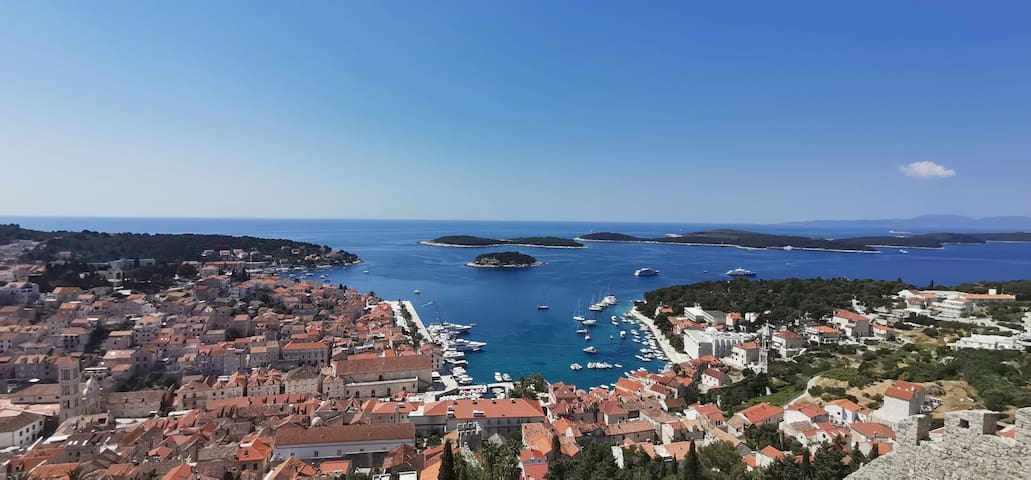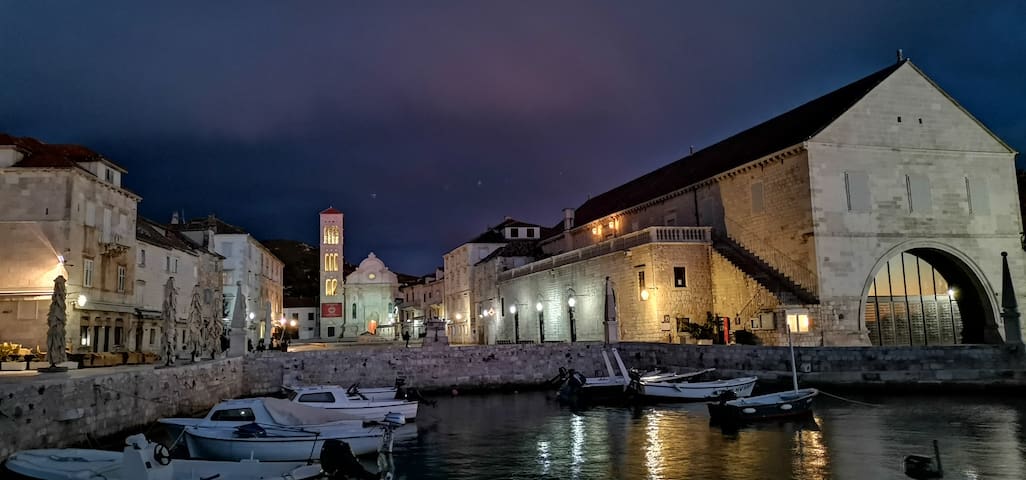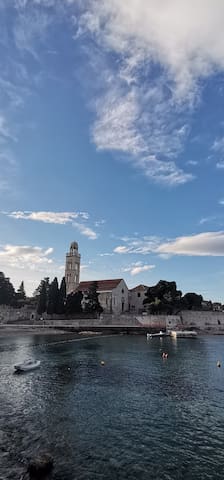Cultural & Historic Sites
You walk from the square to the north, passing the main city Gate of Dates ascending the stairs through the old part of the city in which there are palaces built in the 15th and 16th centuries, through small bends that give out the aromas of Mediterranean plants, you will reach Hvar's fort Fortica or how the locals call it Španjola. Built at the beginning of the 16th century (during the Venetian rule) and was reconstructed in 1579.
Besides experiencing its exquisite architecture, you will experience an unforgettable panoramic view of the city of Hvar, its surroundings and the Pakleni islands.
59 locals recommend
Spanish Fortress
80 Ul. Biskupa Jurja DubokovicaYou walk from the square to the north, passing the main city Gate of Dates ascending the stairs through the old part of the city in which there are palaces built in the 15th and 16th centuries, through small bends that give out the aromas of Mediterranean plants, you will reach Hvar's fort Fortica or how the locals call it Španjola. Built at the beginning of the 16th century (during the Venetian rule) and was reconstructed in 1579.
Besides experiencing its exquisite architecture, you will experience an unforgettable panoramic view of the city of Hvar, its surroundings and the Pakleni islands.
Square & Cathedral of St. Stephen - Episcopal Palace -
If you visit Hvar, all the streets will lead you to Hvarska pjaca (Hvar's square), the centre of city's public and social life and the largest square in Dalmatia. The eastern side of the square is surrounded by the Cathedral of St. Stephen that was built on the foundations of an early-Christian church from the 6th century and that acquired its present appearance in the 16th and 17thcentury. The Cathedral is dedicated to St. Stephen, a pope and martyr, the protector of the Diocese and the city of Hvar.
Hvar's Cathedral preserves many valuable items and paintings of famous painters .
42 locals recommend
Saint Stephen
Trg Sv. StjepanaSquare & Cathedral of St. Stephen - Episcopal Palace -
If you visit Hvar, all the streets will lead you to Hvarska pjaca (Hvar's square), the centre of city's public and social life and the largest square in Dalmatia. The eastern side of the square is surrounded by the Cathedral of St. Stephen that was built on the foundations of an early-Christian church from the 6th century and that acquired its present appearance in the 16th and 17thcentury. The Cathedral is dedicated to St. Stephen, a pope and martyr, the protector of the Diocese and the city of Hvar.
Hvar's Cathedral preserves many valuable items and paintings of famous painters .
Once you are on Hvar's square you will certainly wish to visit Hvar's theatre that holds an unavoidable place in the general history of theatre. Its foundation in 1612 made it become the first civic theatre in Europe. The theatre was erected above the Arsenal, the most recognisable outline of the city of Hvar, a place that was used for the repair of galleys and served as a warehouse for nautical accessories. Today Hvar's theatre is open for public use
17 locals recommend
Hvarsko kazalište
44 Trg svetog StjepanaOnce you are on Hvar's square you will certainly wish to visit Hvar's theatre that holds an unavoidable place in the general history of theatre. Its foundation in 1612 made it become the first civic theatre in Europe. The theatre was erected above the Arsenal, the most recognisable outline of the city of Hvar, a place that was used for the repair of galleys and served as a warehouse for nautical accessories. Today Hvar's theatre is open for public use
An easy stroll from Hvar's square, along the sea and the waterfront soon brings you to the Franciscan monastery. Within the peace and quiet of the monastery walls, you can enjoy a rich display of museum exhibits (collections of Greek, Roman and Venetian coins, liturgical items, atlas of the ancient cartographer Ptolemaeus, rare exhibits of amphora, etc.), as well as paintings of Venetian artists like Francesco Santacroce and Palma Junior. The monastery is known for its magnificent painting of the Last Supper (2 x 8 m) which leaves everyone breathless. Some critics believe it is the work of a painter from Ravenna Matteo Ingoli, whilst others think that the painting belongs to the school of Palma Junior. One more rarity that makes the monastery famous is the 300-year old cypress that is located in the garden of the monastery.
111 locals recommend
Franciscan Monastery
Šetalište put KrižaAn easy stroll from Hvar's square, along the sea and the waterfront soon brings you to the Franciscan monastery. Within the peace and quiet of the monastery walls, you can enjoy a rich display of museum exhibits (collections of Greek, Roman and Venetian coins, liturgical items, atlas of the ancient cartographer Ptolemaeus, rare exhibits of amphora, etc.), as well as paintings of Venetian artists like Francesco Santacroce and Palma Junior. The monastery is known for its magnificent painting of the Last Supper (2 x 8 m) which leaves everyone breathless. Some critics believe it is the work of a painter from Ravenna Matteo Ingoli, whilst others think that the painting belongs to the school of Palma Junior. One more rarity that makes the monastery famous is the 300-year old cypress that is located in the garden of the monastery.
If you walk through the main city gate towards the north, ascending the stone stairs along the picturesque street of the old part of the city, you will reach the Benedictine nunnery. The Benedictines or as the people of Hvar call them "koludrice" are a very strict order because they do not go beyond the boundaries of the nunnery, unless it is a matter of extreme emergency.
The Benedictine nuns from Hvar have gained world fame for their decorative embroidery, especially the agave lace. The extraction of fibres from agave leaves and its processing to produce fine threads for embroidering are demanding tasks that require exceptional knowledge and patience. For the knitting of the agave lace a special skill is required that the Benedictine nuns have been working on for hundreds of years. Each lace is one of its kind, therefore, it holds special value and is inscribed in the - UNESCO - Representative list of the Intangible Cultural Heritage List of Humanity.
Benedictine Convent
If you walk through the main city gate towards the north, ascending the stone stairs along the picturesque street of the old part of the city, you will reach the Benedictine nunnery. The Benedictines or as the people of Hvar call them "koludrice" are a very strict order because they do not go beyond the boundaries of the nunnery, unless it is a matter of extreme emergency.
The Benedictine nuns from Hvar have gained world fame for their decorative embroidery, especially the agave lace. The extraction of fibres from agave leaves and its processing to produce fine threads for embroidering are demanding tasks that require exceptional knowledge and patience. For the knitting of the agave lace a special skill is required that the Benedictine nuns have been working on for hundreds of years. Each lace is one of its kind, therefore, it holds special value and is inscribed in the - UNESCO - Representative list of the Intangible Cultural Heritage List of Humanity.





